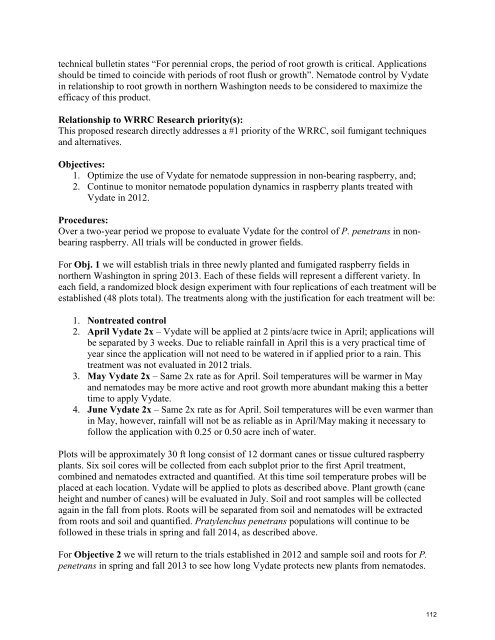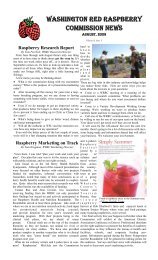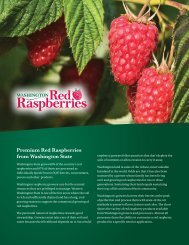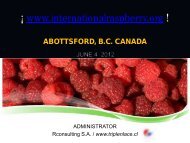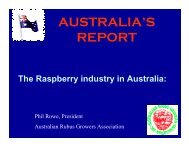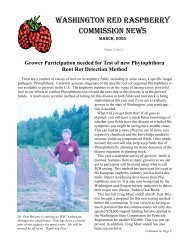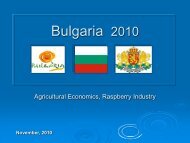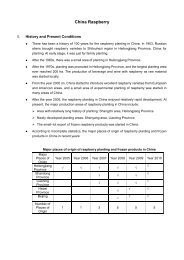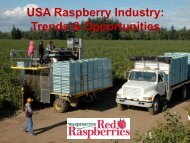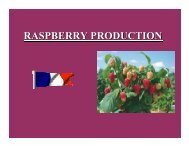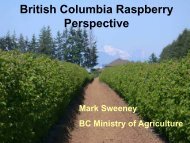2012 - Washington Red Raspberry Commission
2012 - Washington Red Raspberry Commission
2012 - Washington Red Raspberry Commission
Create successful ePaper yourself
Turn your PDF publications into a flip-book with our unique Google optimized e-Paper software.
technical bulletin states “For perennial crops, the period of root growth is critical. Applications<br />
should be timed to coincide with periods of root flush or growth”. Nematode control by Vydate<br />
in relationship to root growth in northern <strong>Washington</strong> needs to be considered to maximize the<br />
efficacy of this product.<br />
Relationship to WRRC Research priority(s):<br />
This proposed research directly addresses a #1 priority of the WRRC, soil fumigant techniques<br />
and alternatives.<br />
Objectives:<br />
1. Optimize the use of Vydate for nematode suppression in non-bearing raspberry, and;<br />
2. Continue to monitor nematode population dynamics in raspberry plants treated with<br />
Vydate in <strong>2012</strong>.<br />
Procedures:<br />
Over a two-year period we propose to evaluate Vydate for the control of P. penetrans in nonbearing<br />
raspberry. All trials will be conducted in grower fields.<br />
For Obj. 1 we will establish trials in three newly planted and fumigated raspberry fields in<br />
northern <strong>Washington</strong> in spring 2013. Each of these fields will represent a different variety. In<br />
each field, a randomized block design experiment with four replications of each treatment will be<br />
established (48 plots total). The treatments along with the justification for each treatment will be:<br />
1. Nontreated control<br />
2. April Vydate 2x – Vydate will be applied at 2 pints/acre twice in April; applications will<br />
be separated by 3 weeks. Due to reliable rainfall in April this is a very practical time of<br />
year since the application will not need to be watered in if applied prior to a rain. This<br />
treatment was not evaluated in <strong>2012</strong> trials.<br />
3. May Vydate 2x – Same 2x rate as for April. Soil temperatures will be warmer in May<br />
and nematodes may be more active and root growth more abundant making this a better<br />
time to apply Vydate.<br />
4. June Vydate 2x – Same 2x rate as for April. Soil temperatures will be even warmer than<br />
in May, however, rainfall will not be as reliable as in April/May making it necessary to<br />
follow the application with 0.25 or 0.50 acre inch of water.<br />
Plots will be approximately 30 ft long consist of 12 dormant canes or tissue cultured raspberry<br />
plants. Six soil cores will be collected from each subplot prior to the first April treatment,<br />
combined and nematodes extracted and quantified. At this time soil temperature probes will be<br />
placed at each location. Vydate will be applied to plots as described above. Plant growth (cane<br />
height and number of canes) will be evaluated in July. Soil and root samples will be collected<br />
again in the fall from plots. Roots will be separated from soil and nematodes will be extracted<br />
from roots and soil and quantified. Pratylenchus penetrans populations will continue to be<br />
followed in these trials in spring and fall 2014, as described above.<br />
For Objective 2 we will return to the trials established in <strong>2012</strong> and sample soil and roots for P.<br />
penetrans in spring and fall 2013 to see how long Vydate protects new plants from nematodes.<br />
112


